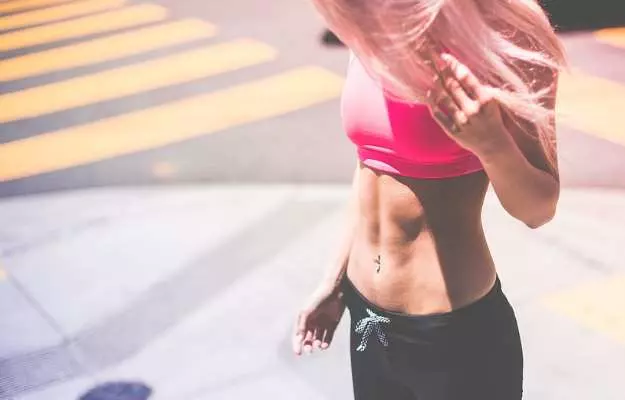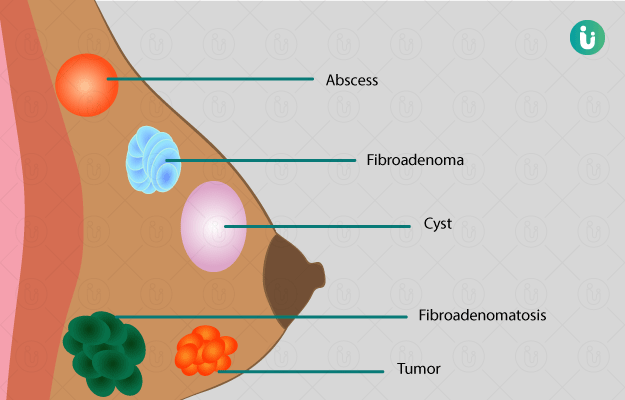Summary
Sagging breasts are one of the many cosmetic concerns among women. Ageing of the breast skin and tissue and fluctuations in the breasts due to hormonal changes may also cause sagging of the breasts. Breast-tightening creams and gels are over-the-counter formulations, which claim to deal with sagginess of the breasts but may show some or no effects at all. Surgery has proven to be a successful mode of treatment for breast tightening. Lifestyle changes like posture correction and chest muscle exercises are an effective alternative to the surgical method.
Why do breasts sag
Some of the causes of breast sagging that are well established by studies are:
- Cigarette smoking
Cigarettes have carcinogens such as nicotine. These carcinogens break down elastin (a connective elastic tissue surrounding the breast) that is responsible for providing firmness to the breasts. - Ageing
A woman’s breast tissue has ligaments that stretch and lose elasticity with age. As a result, the fullness of the breasts is compromised. These changes are evident specifically when a woman is undergoing menopause. - Weight gain
The skin undergoes stretching due to weight fluctuations. Gaining weight can cause stretching of the breast skin and tissue. Rapid weight loss causes the skin to become loose and saggy, making the breasts appear droopy. - Improper support
A supportive bra that is comfortable and provides adequate lift is essential to maintain the shape of the breasts. Heavier breasts experience a greater gravitational pull, giving them a saggy appearance. - Ultraviolet rays
Tanning in the sun without a sunscreen dries out the tissues around the breasts and makes them lose their elasticity. - Multiple pregnancies
- During pregnancy and lactation, the supportive ligaments that hold the breasts in place begin to stretch due to the action of hormones.
- High-intensity workout
Extreme workout without wearing a supportive workout bra can cause sagging of the breasts. The connective tissues in the breasts tend to break down and ultimately result in a droopy breast skin. - Low levels of collagen and oestrogen
Collagen is responsible for the growth and repair of body cells, thus rejuvenating and tightening the skin while oestrogen keeps the elasticity of the skin intact. Depletion of collagen due to any cause, for example, vitamin B and C deficiency, can lead to accelerated ageing of the skin. This, in turn, leads to sagging of breasts and loosening of the overlying skin. Likewise, oestrogen depletion due to factors such as hormonal imbalance or menopause can lead to a loss of elasticity of the skin, hastened ageing and wrinkling of the skin and sagging of the breasts.
Myths about the causes of saggy breasts
- Not wearing a proper bra
It is wrongly thought that wearing an ill-fitted or loose bra that doesn’t support the breasts enough might lead to sagging as you go about your daily activities. - Breastfeeding
Repetitive breastfeeding doesn’t lead to sagging of breasts. - Wearing a bra
This strongly contradicts not wearing a proper bra as a reason for sagging breasts. There is no proof for either of these.
How to tighten the breasts
There are various methods of tightening the breasts. However, not all of them are scientifically proven. Some of these methods include:
Breast tightening exercises
Chest exercises provide strength to the tissues underneath the breasts so that the breasts are better supported. Following are some of the exercises that help strengthen chest muscles, due to which the muscles under the breast also get toned, making the breasts tightened:
- Traditional push-ups
Push-ups are an easy exercise to perform to improve the strength of chest muscles without the need for any equipment. The core and chest muscles become firm and strong as the repetitions of the exercise increase in number. The firmness of the chest muscles thus gives a lift to the breasts. - Bench presses with weights
Doing bench presses with weights will increase the resistance of the shoulder and chest muscles against the weights. Bar weights or dumbbells can be used. This exercise should be done in the presence of another person since lifting weights over the head can be dangerous. These exercises tighten up the chest muscles and provide a lift to the breasts. - High-low ball squeeze
High-low ball squeeze is a simple exercise that can be performed at home using a small exercise ball. A small playground can also be used. Stand with your feet wide apart and make your toes point 45 degrees outward. Bring the ball close to the chest and squeeze it between your palms. While you do that, bend your knees to 90 degrees (just like how you squat). Now extend your hands and knees simultaneously and bring the ball overhead. Repeat the exercise at least 10-15 times. - Advanced dumbbell-fly exercise
Advanced dumbbell-fly exercise uses the same method of bench presses with weights. This exercise can be done while standing as well. Extra muscles are specifically targeted in this exercise. - Swimming
A few laps in a swimming pool provide strength to the muscles of the body. The breaststroke, butterfly stroke and freestyle swimming methods specifically work on the chest and build core muscle strength. - Practice good posture
Standing up straight, holding the head high, drawing the shoulders back, and keeping the neck straight up-and-down helps give an instant boost to the breast line. Pushing out the chest while walking and standing also help get a firmer breast line visually.
Home remedies for Breast tightening
The following methods have worked for some women but lack scientific evidence:
- Breast-tightening creams
The market is flooded with creams for breast tightening, however, most don’t work and those which do in some cases, might not work for you. What these creams really do is temporarily contract or pinch the skin of the breast, giving them an appearance of being tighter. However, this effect is transient and doesn’t last long. Many of these creams contain hyaluronic acid, vitamin E, phytoestrogens, and Retin- A. However, none of these ingredients has any proven benefit for breast tightening. Topical creams can never tighten breasts merely by their application on the skin as the breasts contain layers of muscles and fats and the ingredients of these creams barely penetrate the skin. Breast tightening is successfully done only by surgeries or exercises. - Breast-tightening oils
For the same reasons stated above, massaging with breast tightening oils might not work. - Applying ice
Ice application to the skin on any body part simply contracts the blood vessels of the skin in that region. This reduces the blood supply to that part which effectively reduces any swelling or redness that might have been there earlier. However, ice application cannot possibly tighten the muscles that make up the breasts. - Herbal remedies
Herbal extracts are considered to be a safe remedy mainly because they are natural. However, nothing is safe if taken in excess and without consulting a doctor. According to research, certain plants have shown to be effective in improving the elasticity of the skin and firming it due to the saponosides and phytoestrogens present in them. However, none of them has been scientifically proven to be effective in breast tightening. Some of these herbs are:- Hops (Humulus lupulus)
- Wild yam (Dioscorea villosa)
- Sausage tree (Kigelia africana)
- Fenugreek
Plants like Sichuan pepper (Zanthoxylum bungeanum) and dill (Peucedanum graveolens) have also shown benefits in improving the elasticity of the skin.
Other methods to tighten the breasts
Surgical procedures
- Breast augmentation surgery
Breast reduction or augmentation has been an accepted plastic/cosmetic surgery to enhance the appearance of the breasts. The guidelines by the American Society of Plastic Surgeons for females who are considering a breast augmentation surgery state that the woman should:- be at least 18 years old.
- have the required emotional and physical maturity, which will help achieve a positive outcome.
- have a clear understanding of the potential risks.
- understand the need for an additional surgery if required.
- Mastopexy
Mastopexy, also known as “breast lift surgery”, is performed to improve the shape of the breast. The breast tissue is reshaped by removing excess skin. This gives a proper shape and lift to the breasts. Although this procedure is effective, pregnant women should not consider a mastopexy since the breasts tend to stretch during pregnancy, and this might nullify the mastopexy results. Women with small sagging breasts show lasting effects as compared to women with large sagging breasts. The heavy weight of the larger breasts makes them prone to sagging again. The latest statistics from the American Society of Plastic Surgeons state that mastopexy has overtaken breast implants by a ratio of 2:1 since the year 2000. Some of the potential risks of breast lift surgery are:- Infection.
- Asymmetry of the breasts.
- Accumulation of fluid in the operated area.
- Irregularities in the shape and contour of the breasts.
- A possible partial or total loss of areola and nipple.
- Temporary or permanent changes in sensation.
- Bleeding.
Laser treatment
Laser lipolysis (breakdown of the fats under the skin using a laser) using a dual-wavelength laser diode has been proven to tighten the breast skin with no reported complications during the procedure so far.
References
- World Health Organization [Internet]. Geneva (SUI): World Health Organization; Ultraviolet radiation (UV)
- Rinker B, Veneracion M, Walsh CP. The effect of breastfeeding on breast aesthetics. 2008 Sep-Oct;28(5):534-7. PMID: 19083576
- U.S. Department of Veterans Affairs. Chest. Washington DC
- Cleveland Clinic. [Internet]. Cleveland, Ohio. Back Health & Posture
- Barbara G, Facchin F, Buggio L, Alberico D, Frattaruolo MP, Kustermann A. Vaginal rejuvenation: current perspectives. 2017 Jul 21;9:513-519. PMID: 28860864
- Barbara G, Facchin F, Buggio L, Alberico D, Frattaruolo MP, Kustermann A.Vaginal rejuvenation: current perspectives. 2017 Jul 21;9:513-519. PMID: 28860864
- Ivana Binic, Viktor Lazarevic, Milanka Ljubenovic, Jelena Mojsa and Dusan Sokolovic. Skin Ageing: Natural Weapons and Strategies. 2013; 2013: 827248. PMID: 23431351
- Wolfenson M, Hochman B, Ferreira LM. Laser lipolysis: skin tightening in lipoplasty using a diode laser.. 2015 May;135(5):1369-77. PMID: 25919251


























